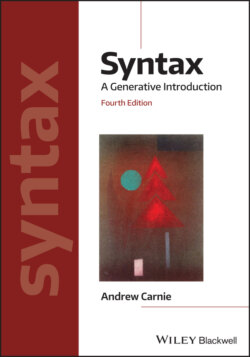Читать книгу Syntax - Andrew Carnie - Страница 26
IDEAS, RULES, AND CONSTRAINTS INTRODUCED IN THIS CHAPTER
Оглавление1 Linguistics: The scientific study of language.
2 Syntax (the field): The scientific study of sentence structure
3 Syntax (as part of grammar): The level of linguistic organization that mediates between sounds and meaning, where words are organized into phrases and sentences.
4 The Scientific Method: Observe some data, make generalizations about that data, draw a hypothesis, test the hypothesis against more data.
5 Falsifiable Prediction: To prove that a hypothesis is correct you have to look for the data that would prove it wrong. The prediction that might prove a hypothesis wrong is said to be falsifiable.
6 Grammar: Not what you learned in school. This is the set of mental rules or procedures that generate a sentence.
7 Prescriptive Grammar: The grammar rules as taught by so-called “language experts”. These rules, often inaccurate descriptively, prescribe how people should talk/write, rather than describe what they actually do.
8 Descriptive Grammar: A scientific grammar that describes, rather than prescribes, how people talk/write.
9 Anaphor: A word that ends in -self or -selves (a better definition will be given in chapter 5).
10 Antecedent: The noun an anaphor refers to.
11 Asterisk (*): The mark used to mark syntactically ill-formed (unacceptable or ungrammatical) sentences. The hash mark, pound, or number sign (#) is used to mark semantically strange, but syntactically well-formed, sentences.
12 Grammatical Gender: Masculine vs. Feminine vs. Neuter. Does not have to be identical to the actual sex or gender identity of the referent. For example, a dog might be female, but we can refer to it with the neuter pronoun it. Similarly, boats don’t have a sex, but are grammatically feminine.
13 Number: The quantity of individuals or things described by a noun. English distinguishes singular (e.g., a cat) from plural (e.g., cats). Other languages have more or less complicated number systems.
14 Person: The perspective of the participants in the conversation. The speaker or speakers (I, me, we, us) are called the first person. The addressee(s) (you) is called the second person. Anyone else (those not involved in the conversation) (he, him, she, her, it, they, them) is referred to as the third person.
15 Case: The form a noun takes depending upon its position in the sentence. We discuss this more in chapter 11.
16 Nominative: The form of a noun in subject position (I, you, he, she, it, we, they).
17 Accusative: The form of a noun in object position (me, you, him, her, it, us, them).
18 Corpus (pl. Corpora): A collection of real-world language data.
19 Native Speaker Judgments (Intuitions): Information about the subconscious knowledge of a language. This information is tapped by means of the acceptability judgment task.
20 Semantic Judgment: A judgment about the meaning of a sentence, often relying on our knowledge of the context in which the sentence was uttered.
21 Syntactic Judgment: A judgment about the form or structure of a sentence.
22 Garden Path Sentence: A sentence with a strong ambiguity in structure that makes it hard to understand.
23 Center Embedding: A sentence in which a relative clause consisting of a subject and a verb is placed between the main clause subject and verb. E.g., The house [Bill built] leans to the left.
24 Parsing: The mental tools a listener uses to process and understand a sentence.
25 Competence: What you know about your language.
26 Performance: The real-world behaviors that are a consequence of what you know about your language.
27 i-language: This is the cognitive structure underlying your ability to speak a language. The i- stands for “internal”. This is the primary object of study in this book.
28 e-language: The outward expression of a particular language like English, French or Mandarin. The e- stands for “external”. These are the particular instances of the human ability to speak an i-language. The data sources we use to examine i- language are e-languages.
29 Human Language Capacity (HLC). The general ability to have an i-language and to express an e-language.
30 Generative Grammar: A theory of linguistics in which grammar is viewed as a cognitive faculty. Language is generated by a set of rules or procedures. The version of generative grammar we are looking at here is primarily the Principles and Parameters approach (P&P), and we will be touching occasionally on Minimalism, a more recent approach.
31 Learning: The gathering of conscious knowledge (like linguistics or chemistry).
32 Acquisition: The gathering of subconscious information (like language).
33 Innate: Hard-wired or built-in, an instinct.
34 Recursion: The ability to embed structures iteratively inside one another. Allows us to produce sentences we’ve never heard before.
35 Universal Grammar (UG): The innate (or instinctual) part of each language’s grammar.
36 The Logical Problem of Language Acquisition: The proof that an infinite system like human language cannot be learned on the basis of observed data – an argument for UG.
37 Poverty of the stimulus: The idea that we know things about our language that we could not have possibly learned – an argument for UG.
38 Universal: A property found in all the languages of the world.
39 Bioprogram Hypothesis: The idea that creole languages share similar features because of an innate basic setting for language.
40 Observationally Adequate Grammar: A grammar that accounts for observed real-world data (such as corpora).
41 Descriptively Adequate Grammar: A grammar that accounts for observed real- world data and native speaker judgments.
42 Explanatorily Adequate Grammar: A grammar that accounts for observed real- world data and native speaker judgments and offers an explanation for the facts of language acquisition.
FURTHER READING: Baker (2001b), Barsky (1997), Bickerton (1984), Chomsky (1965), Duffield (2018), Ghomeshi (2010), Jackendoff (1993), Sampson (1997), Uriagereka (1998)
